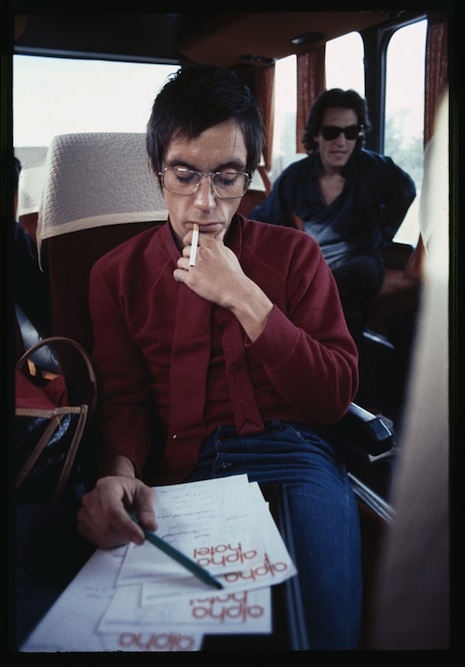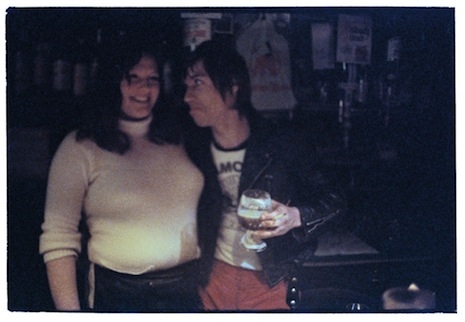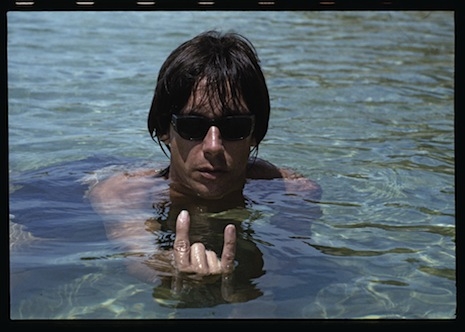
With mannequins in a comic book shop in Boston, 1980
On February 21 of this year the well-regarded German newspaper Die Zeit ran an exclusive interview with Esther Friedman, who was Iggy Pop’s girlfriend for seven years, from roughly 1976 to 1982. They met while Iggy was living in West Berlin with David Bowie, where the two rock stars were hoping to dry out after a period of heavy drug use. Iggy and Bowie lived at Hauptstrasse 155 in Schöneberg. At that time, Friedman was a prolific photographer, and she took many revealing photographs of Iggy Pop in various locales. The cover photo for Iggy’s 1982 album Zombie Birdhouse was taken by Friedman during a 1981 vacation to Haiti.
At Hansa Studios near the Berlin Wall, Iggy recorded The Idiot and Lust for Life, both produced by Bowie, while Bowie cut his three legendary “Berlin period” albums Low, Heroes, and Lodger during the same period.
In the interview, Friedman spoke openly about her life with Iggy. He comes across as rather different from his public image—shy instead of outgoing. Friedman discusses the origins of one of Iggy’s greatest songs, “The Passenger,” as well as the sharp differences between Iggy’s frenetic stage persona and his offstage self, whom Friedman called “Jim,” as in James Osterberg, Iggy’s real name. Obviously, the interview is in German—but here are some excerpts from Friedman’s interview with Die Zeit, or actually ZEITmagazin, which is sort of the German equivalent of the New York Times Magazine (translation by Martin Schneider):
ZEITmagazin: Did you call Iggy Pop “Jim” from the very start?
Esther Friedman: Yes, his proper name is James Osterberg, but I always called him Jim, never Iggy. He named himself Iggy when he was 18. His first band was the Iguanas, so that’s where that came from. David [Bowie] always used to call him Jimmy in Berlin, his parents called him Jim. Iggy is his stage name. And there are actually two characters, there’s Iggy, and there’s James.
ZEITmagazin: What is the difference between the two?
Esther Friedman: The difference is rather large. Iggy is 99 percent unbearable. And James, Jim, is 99 percent bearable.-snip-
Esther Friedman: Berlin left Jim alone. In Berlin Jim could just be Jim when he wanted to, he could live, sit in the local bar next door and drink a beer. He loved it. David had studied the literature and art that came from Berlin or took place in Berlin. Christopher Isherwood’s book Goodbye to Berlin from 1939, the works of the “Die Brücke” group—all of that fascinated David, and he took Jim with him. They often went to the Brücke Museum. “The Passenger” ...
ZEITmagazin: ...Iggy Pop’s greatest hit…
Esther Friedman: ...well, it’s a hymn to Berlin’s S-Bahn [Stadtschnellbahn, light rail system]. Jim went on the S-Bahn almost every day. Those trips inspired him to write the song, especially the section that goes out to the Wannsee. Jim and David also frequently traveled together to East Berlin, in a Mercedes-Benz 600 that David’s chauffeur took care of.
-snip-
ZEITmagazin: Is it true that Iggy Pop was in a telephone booth and some punk locked him in from the outside?
Esther Friedman: Yes, that happened at three o’clock in the morning. Telephone booths actually used to have locks. Jim had just come from the Dschungel Club in Nürnberger Strasse and called me: “Listen, I’m locked in a telephone booth here! You have to help me!” I said, “Think up a better story. How come you’re calling me at three in the morning and waking me up?” Then I hung up.
ZEITmagazin: Why?
Esther Friedman: Maybe I can explain it this way: When he called at three in the morning, it was not Jim on the line, but Iggy.
ZEITmagazin: The boisterous punk rocker.
Esther Friedman: The poor guy, he sat in that phone booth until six in the morning. A taxi driver discovered him and was able to open the door with a master key. To this day we don’t know who locked him in there.

Esther Friedman and Iggy Pop were together for seven years.

Esther Friedman in Berlin-Schöneberg, photographed by Iggy Pop

Iggy Pop during the “Lust for Life” tour in the US, 1978

In Berlin, 1977

Striking a James Bond pose in a Berlin subway station, 1979. Taken with an old Rolleicord camera.

Iggy Pop poses with a waitress in a bar in Berlin-Schöneberg, 1977

Iggy Pop in South Carolina, on the way to see his parents, 1982

On the island of St. Barth, 1979
There are plenty more where these came from at Die Zeit.
Previously on Dangerous Minds:
Bowie and Iggy: Hot chicks
Iggy Pop performs ‘Bang, Bang’ on German TV, from 1981
Iggy does the dog at Virgin Megastore Paris 1990
Just a photo of Iggy Pop vacuuming